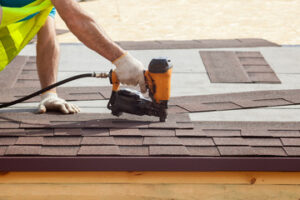Palm Coast Roofers keep the structural integrity of buildings intact. Their precise installations and repairs protect interiors from weathering and preserve insulation. Without them, building structures would succumb to leaks and other issues.
Whether they are shingling residential homes or installing metal roofs on commercial facilities, roofers have a demanding job that requires both physical strength and customer service skills. They must also abide by safety regulations when working on rooftops.
Roofers install, replace, and repair the roofs of homes and businesses. Their work ensures that buildings are watertight and safe for occupants. They use a wide range of tools to perform their tasks, including roofing shovels, roof cutters, pry bars, and hammers. They also need to have access to a ladder and safety harness.
Before beginning a new installation, roofers prepare the area by removing any existing materials and cleaning the surface. They also inspect the roof deck for damage and make repairs as needed. This step is important because it helps prevent leaks and other problems down the line. Next, the roofer applies underlayment to the roof deck. This material is often felt paper or a synthetic substance. It creates a barrier that sheds water and protects the framing and sheathing from moisture and rot.
Once the underlayment is in place, the roofer can begin laying shingles. They start at the bottom and work their way up, making sure each shingle is properly placed and secured. Roofers usually work with asphalt shingles, but they may also lay tile, metal, slate, or shakes (rough wooden shingles).
After the shingles are in place, roofers apply an ice and water barrier to the underside of the roof. This helps prevent ice dams and windblown rain from damaging the roof. They may also add drip edges to the sides of the roof. This is particularly important if the roof has a low slope.
Finally, roofers finish up the job by adding flashing to the corners of the roof and around vents and chimneys. This is a crucial part of the roof’s structure, as it keeps water and other elements from seeping into the building. It’s also a good idea for roofers to apply waterproof sealants to the joints in the flashing and around the chimney.
Roofers can also install skylights in residential roofs. This type of home improvement is a great way to add natural light and improve energy efficiency. Professional roofers are familiar with the different types of skylights available and can recommend the best options for a home’s architecture and interior layout.
Repair
Roofers repair and replace the shingles, asphalt, metal and other associated roofing materials on commercial buildings, residential homes and other structures. They often need to use scaffolding to get to hard-to-reach areas. Roofers must also be able to recognize and fix problems with the structure of the roof, such as rot or mold.
Roof repair is a common service that many homeowners need, and it can be fairly inexpensive depending on the extent of the damage. A roofer may be able to simply reattach curled or detached shingles, or they might need to scrape off the old shingle and then apply a new layer of shingles. Other repairs may involve fixing or replacing a flashing, vent pipe boots, or other roof components.
In the event of a major leak, a roofer will need to examine the entire structure of the roof. This can be a messy job, so it’s important for the roofer to have protective measures in place, such as covering furniture and other belongings from dust and debris. They should also be able to clear off the debris after the job is done.
If a homeowner doesn’t respond to an estimate or fails to schedule or complete the work, the roofer should send them a recorded letter letting them know they intend to carry out the repair using another vendor, and then bill them for the cost. The letter should be polite but matter-of-fact, and give the homeowner a specific number of days to respond (e.g. ten).
Maintenance
Roofers repair and install roofs to ensure buildings have enough protection for the people inside. They use a variety of roofing materials to ensure structures are waterproof and have the structural integrity needed. They also use standard maintenance procedures like cleaning gutters and removing debris to avoid problems. In addition to these tasks, they must maintain their tools and keep them in good working condition. They also need to be familiar with a variety of building and safety regulations.
While a roofer’s job can be dangerous, they take many precautions to prevent accidents and injuries. For example, they wear hard hats and harnesses when working on a roof. They may also use a fall arrest system that’s secured to anchor points on the roof and will catch them if they accidentally fall. Ladders and scaffolding are another risk for roofers, so they need to be careful when using these items. They should always check the weather forecast before starting a project. Unfavorable conditions such as rain, high winds and extreme heat can make a project more difficult or even dangerous for them. They may decide to rearrange their schedules or find a different location for the work if the weather is bad.
A roofer’s main responsibilities are to install and repair residential and commercial roofs. This involves working with a wide range of materials, including asphalt shingles, metal panels and tiles. They often need to inspect roofs for damage and leaks and recommend the best repairs. Roofers can also use their expertise to install and maintain green roofs, which are made from plants and serve as insulation for a building’s structure.
Roofers are typically employed by construction businesses or roofing contractors. However, some roofers are independent contractors who provide services for both homeowners and business owners. Those who are members of a roofers’ union may advance to become a supervisor, job superintendent or estimator. In some cases, they can start their own roofing companies. For those who are interested in pursuing careers as roofers, it is important to have the right skills and mentality. These include having strong problem-solving abilities, excellent communication skills and being detail-oriented. In addition, a willingness to learn new skills and work at heights is essential for this occupation.
Inspection
Whether working on a new construction project or an existing roof, roofers must inspect it regularly to ensure that the structure is intact and that no problems are developing. They are trained to identify a wide range of issues, from the easily visible (missing or damaged shingles) to the less obvious (corroded flashing, sagging areas) and can even spot leaks in ceilings and walls. These professionals are also skilled at assessing the remaining lifespan of a roof and recommending appropriate maintenance procedures.
The initial inspection involves getting up on the roof to physically examine its condition. This includes looking at the shingles themselves for cracks, blistering, moss growth and other problems. It also includes examining the gutters and downspouts for damage, clogs or other issues that could prevent water from draining off the roof. Roofers will also check the flashing around chimneys, skylights and vents to make sure that it is securely attached and free from rust or other signs of wear.
This inspection is important because it can help identify potential problems before they become worse. For instance, a small leak in the attic can lead to serious and expensive water damage over time if not repaired, so it’s crucial for roofers to catch these issues early on. A professional will be able to assess the severity of the issue and recommend an appropriate course of action, from minor repairs to full replacement.
During the inspection, the roofer will also look at the attic to see if there are any water stains or other indications of leaks. If there are any problems, the roofer will be able to provide a quote for the work that needs to be done and will be able to advise the homeowner on the best course of action. If the roof is nearing the end of its life, the roofer will be able to recommend a suitable replacement and give an estimate for the cost. This can help the homeowner plan for future expenses and ensure that the roof will remain in good condition for as long as possible.
